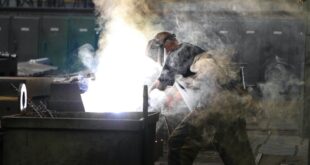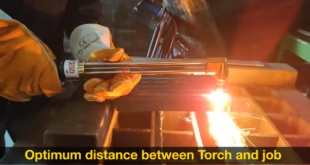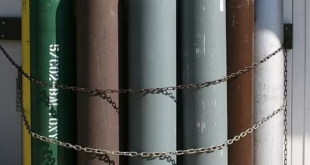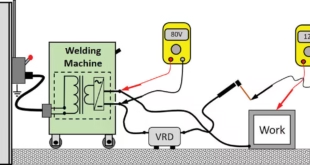What is backfire in welding?
Welding is a process that joins materials, typically metals, by applying high heat to melt the parts together and allowing them to cool, causing fusion. There are various types of welding, including arc welding, gas welding, and resistance welding, each with its own set of tools, techniques, and risks. Among the various challenges that welders face, backfire is one of the most critical.
Backfire is a sudden, uncontrolled ignition of gases inside the welding torch, often accompanied by a popping sound. While it might seem minor, backfire can lead to severe accidents, equipment damage, and poor-quality welds if not addressed properly. Understanding the causes and mechanisms of backfire is essential for every welder to ensure safety and maintain the quality of their work.
Understanding Backfire: Definition and Mechanism
Backfire in welding occurs when the flame momentarily burns back into the welding torch. This can result in a popping sound and, in some cases, a momentary extinguishment of the flame. The phenomenon can happen during various types of welding processes, but it is particularly common in oxy-fuel welding and cutting.
Mechanism of Backfire: Backfire is primarily caused by the reverse flow of gases inside the torch. Normally, the gases (oxygen and fuel gas) flow out of the torch tip to sustain a stable flame. However, under certain conditions, the flow can reverse, causing the flame to momentarily burn back into the torch. This can happen due to several reasons, including incorrect gas pressures, obstructions in the torch tip, or faulty equipment.
Types of Backfire in Welding
Backfire is often confused with flashback, another dangerous phenomenon in welding. It’s important to distinguish between the two:
- Backfire: A backfire is a momentary flashback that occurs inside the welding torch, often causing a popping sound. The flame may or may not extinguish, and it usually happens when the torch tip touches the workpiece or when there is a sudden change in gas flow.
- Flashback: A flashback is more severe than a backfire. It occurs when the flame travels back through the torch and into the hose, potentially reaching the gas supply. Flashback can cause explosions and is far more dangerous.
Causes of Backfire in Welding
A variety of factors can cause backfire. Understanding these causes is the first step toward preventing them and ensuring a safe welding environment.
Incorrect Gas Pressure
One of the most common causes of backfire is incorrect gas pressure. The gas pressure settings are critical for maintaining a stable flame. If the pressure of the fuel gas (acetylene, propane, etc.) or oxygen is too high or too low, it can lead to an unstable flame that is prone to backfire.
- High Pressure: When the gas pressure is too high, the flame becomes excessively turbulent, increasing the risk of backfire.
- Low Pressure: If the pressure is too low, the gas flow may not be sufficient to sustain the flame, causing it to burn back into the torch.
Faulty Equipment
Faulty or poorly maintained equipment is another major cause of backfire. Components such as hoses, regulators, and torch tips need to be in good working condition to prevent issues during welding. Common equipment-related causes include:
- Worn or Damaged Torch Tips: A worn or damaged torch tip can cause irregular gas flow, leading to backfire.
- Leaky Hoses: Hoses that are cracked, damaged, or improperly connected can cause gas leaks, resulting in an unstable flame and increased risk of backfire.
- Faulty Regulators: Regulators that are not functioning properly can cause fluctuations in gas pressure, leading to backfire.
Regular inspection and maintenance of welding equipment are crucial to prevent backfire incidents.
Contaminated or Damaged Torch Tip
A contaminated or damaged torch tip is a common yet often overlooked cause of backfire. Over time, torch tips can accumulate debris, soot, or metal particles, which can obstruct the gas flow and cause irregularities in the flame. This obstruction can lead to backfire, as the gases are not flowing smoothly out of the torch tip.
Improper Welding Techniques
Inexperienced or poorly trained welders may inadvertently cause backfire by using improper techniques. For example, allowing the torch tip to come into contact with the workpiece or using the wrong angle can cause a backfire. Other technique-related causes include:
- Holding the Torch Too Close: When the torch is held too close to the workpiece, the flame can become unstable, leading to backfire.
- Sudden Movements: Abrupt changes in torch movement or direction can cause fluctuations in gas flow, increasing the risk of backfire.
- Incorrect Flame Settings: Using a flame that is too small or too large for the job can lead to backfire.
Environmental Factors
Environmental factors can also play a role in causing backfire. For instance, welding in a drafty or windy environment can cause the flame to become unstable, leading to backfire. Similarly, welding in an environment with extreme temperatures can affect the gas flow and torch performance, increasing the risk of backfire.
Other environmental factors that can contribute to backfire include:
- Presence of Flammable Gases: If there are flammable gases in the vicinity of the welding area, they can be ignited by the torch, causing backfire.
- Poor Ventilation: Inadequate ventilation can lead to the buildup of gases, increasing the risk of backfire.
How to Prevent Backfire in Welding
Preventing backfire involves a combination of proper equipment maintenance, correct gas pressure settings, proper techniques, and awareness of environmental factors. Here’s a detailed look at how to prevent backfire in welding.
Equipment Maintenance and Inspection
Regular maintenance and inspection of welding equipment are essential for preventing backfire. Key steps include:
- Inspect Torch Tips: Regularly clean and inspect torch tips to ensure they are free of debris and damage.
- Check Hoses and Connections: Inspect hoses for leaks, cracks, and proper connections. Replace damaged hoses immediately.
- Test Regulators: Ensure that gas regulators are functioning properly and are set to the correct pressure.
- Use Flashback Arrestors: Install flashback arrestors on both the oxygen and fuel gas lines to prevent flashbacks and backfires.
Correct Gas Pressure and Flow Rate
Maintaining the correct gas pressure and flow rate is critical for preventing backfire. To ensure proper settings:
- Follow Manufacturer Guidelines: Always follow the manufacturer’s recommendations for gas pressure settings.
- Use Proper Gauges: Ensure that the pressure gauges are accurate and functioning properly.
- Adjust for the Job: Adjust the gas pressure based on the specific welding task and the type of material being welded.
Proper Technique and Training
Proper welding techniques are crucial for preventing backfire. Welders should:
- Maintain Proper Distance: Keep the torch at the recommended distance from the workpiece to ensure a stable flame.
- Avoid Sudden Movements: Move the torch smoothly and avoid sudden changes in direction or speed.
- Use Correct Flame Settings: Adjust the flame size according to the job requirements and material thickness.
Safety Measures and Protective Gear
Safety should always be a priority in welding. To minimize the risk of injury from backfire:
- Wear Protective Gear: Always wear appropriate protective gear, including gloves, safety glasses, and fire-resistant clothing.
- Use Flashback Arrestors: As mentioned earlier, flashback arrestors are essential for preventing backfire and flashback incidents.
- Be Aware of Surroundings: Ensure that the welding area is free of flammable materials and well-ventilated.
Backfire Safety
Despite taking precautions, backfire incidents can still occur. Knowing how to respond quickly and safely is crucial:
- Immediate Action: If a backfire occurs, turn off the gas supply immediately to stop the flow of fuel.
- Inspect Equipment: After a backfire, inspect the torch, hoses, and regulators for any damage before resuming work.
- Report and Record: Document the incident and report it to the appropriate safety personnel to ensure proper follow-up.
Conclusion
Backfire in welding is a serious issue that can lead to accidents, equipment damage, and poor-quality work. However, with the right knowledge, equipment, and techniques, it can be effectively prevented. Understanding the causes of backfire, from incorrect gas pressure to faulty equipment and environmental factors, is the first step in maintaining a safe and efficient welding environment.
By investing in proper training, maintaining equipment, and adhering to safety protocols, welders can minimize the risk of backfire and ensure that their work is both safe and of high quality. Whether you’re a professional welder or a hobbyist, awareness and prevention are key to avoiding the dangers of backfire and achieving successful welding outcomes.
 Welding of Welders All about Welding and Welders
Welding of Welders All about Welding and Welders




